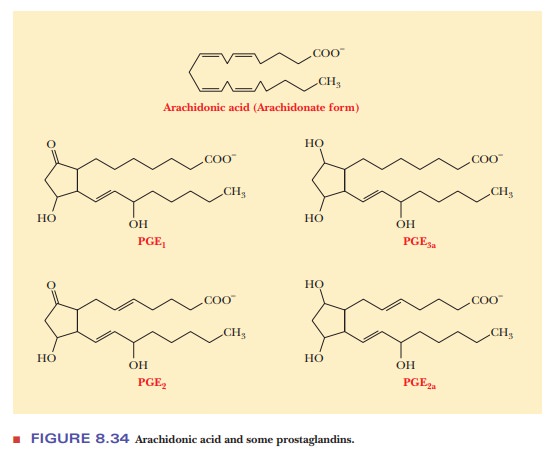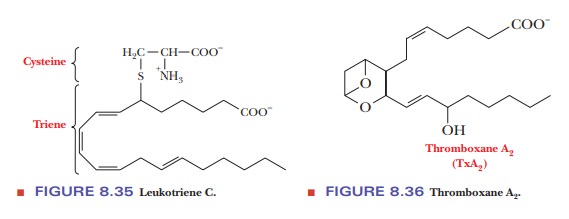Chapter: Biochemistry: Lipids and Proteins Are Associated in Biological Membranes
Prostaglandins and Leukotrienes
Prostaglandins and Leukotrienes
What do prostaglandins and leukotrienes have to do with lipids?
A group
of compounds derived from fatty acids has a wide range of physiological
activities; they are called prostaglandins
because they were first detected in seminal fluid, which is produced by the
prostate gland. It has since been shown that they are widely distributed in a
variety of tissues. The metabolic precursor of all prostaglandins is arachidonic acid, a fatty acid that
contains 20 carbon atoms and four double bonds. The double bonds are not
conjugated. The production of the prostaglandins from arachidonic acid takes
place in several steps, which are catalyzed by enzymes. The prostaglandins
themselves each have a five-membered ring; they differ from one another in the
numbers and positions of double bonds and oxygen-containing functional groups
(Figure 8.34).

The
structures of prostaglandins and their laboratory syntheses have been topics of
great interest to organic chemists, largely because of the many physi-ological
effects of these compounds and their possible usefulness in the phar-maceutical
industry. Some of the functions of prostaglandins are control of blood
pressure, stimulation of smooth-muscle contraction, and induction of
inflammation. Aspirin inhibits the synthesis of prostaglandins, particularly in
blood platelets, a property that accounts for its anti-inflammatory and
fever-reducing properties. Cortisone and other steroids also have
anti-inflammatory effects because of their inhibition of prostaglandin
synthesis.
Prostaglandins
are known to inhibit the aggregation of platelets. They may thus be of
therapeutic value by preventing the formation of blood clots, which can cut off
the blood supply to the brain or the heart and cause certain types of strokes
and heart attacks. Even if this behavior were the only useful property of
prostaglandins, it would justify considerable research effort. Heart attacks
and strokes are two of the leading causes of death in industrialized countries.
More recently, the study of prostaglandins has been a topic of great interest
because of their possible antitumor and antiviral activity.
Leukotrienes are compounds that, like
prostaglandins, are derived fromarachidonic acid. They are found in leukocytes
(white blood cells) and have three conjugated double bonds; these two facts
account for the name. (Fatty acids and their derivatives do not normally
contain conjugated double bonds.) Leukotriene C (Figure 8.35) is a typical
member of this group; note the 20 carbon atoms in the carboxylic acid backbone,
a feature that relates this com
An important property of
leukotri-enes is their constriction of smooth muscle, especially in the lungs.
Asthma attacks may result from this constricting action because the synthesis
of leu-kotriene C appears to be facilitated by allergic reactions, such as a
reaction to pollen. Drugs that inhibit the synthesis of leukotriene C are now
being used in the treatment of asthma, as are other drugs designed to block
leukotriene receptors. In the United States, the incidence of asthma has
increased drasti-cally since 1980, providing considerable incentive to find new
treatments. The Centers for Disease Control (CDC) have made information
available on the Internet at http:/
www.cdc.gov/asthma.) Leukotrienes may also have inflam-matory properties
and may be involved in rheumatoid arthritis.

Thromboxanes
are a third class of derivatives of arachidonic acid. They con-tain cyclic
ethers as part of their structures. The most widely studied member of the
group, thromboxane A2 (TxA2)
(Figure 8.36), is known to induce platelet aggregation and smooth-muscle
contraction.
Summary
Prostaglandins are compounds
of related structures derived from long-chain fatty acids. They have a number
of physiological roles, including control of smooth muscle contraction, development
of inflammation, and inhibition of platelet aggregation. The last of these
three roles makes them objects of research on ways to prevent heart disease.
Leukotrienes
are also derived from fatty acids. They play a role in smooth muscle contraction
in the lungs. Drugs that block the binding of leuko-trienes to their receptors
in lung tissue are under study for the treatment of asthma.
Related Topics